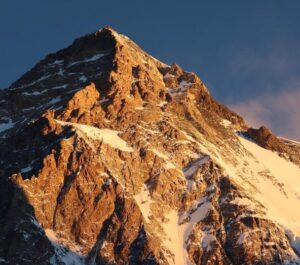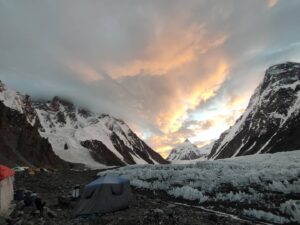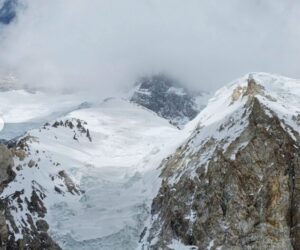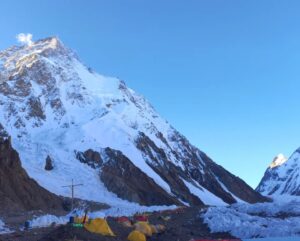Flor Cuenca of Peru doesn’t make as many headlines as record-seekers or influencers. Yet she summited K2 on July 27 without supplementary O2 or Sherpa support, just as she had done on her five previous 8,000m summits. She usually avoids spending too much time on social media. But today, she has something to say to the world, and it is not about herself.
She had witnessed irresponsible behavior toward mountains before, but what she just saw on K2 made her snap. The Peruvian woman has come forward to demand respect for the mountains. She blames the bigger companies for cultivating an atmosphere of neglect.

Flor Cuenca at Camp 4 on K2 on her final acclimatization. Photo: Flor Cuenca
In an exclusive interview with ExplorersWeb, she explains that the problem of garbage piling up in the higher camps is only one of several but it’s the most urgent. She posted a video showing some of the garbage she’s referring to.
A mountain woman
Cuenca defines herself as a Hirkawarmi — a mountain woman of Quechua, a daughter of the Andes of her childhood. She was born in the mountains of Ankash, Peru, at 3,500m. Growing in a peasant family, she had to climb 1,000m to tend the family sheep.
She stepped on the Cordillera Blanca’s glaciers for the first time when she was 13.
In the Himalaya, she has climbed Cho Oyu, Manaslu, Gasherbrum I, Dhaulagiri and. This summer k2. She has never used supplementary O2 or personal Sherpa support. She lives and works in Germany, and saves all she can to fund her expeditions.
On K2 this summer, she joined forces with Iman Ahmadpour of Iran, whom she met in Base Camp. They summited on July 28 in bad weather while breaking trail in fresh snow. On the way down, she helped a climber in trouble, and had to rappel the Black Pyramid in a storm. But it was what she saw in the camps along the way that most affected her.
A garbage dump
“On K2, Camp 1 and Camp 2 are a garbage dump, a pigsty,” Cuenca exclaims. “Human waste is everywhere. The place is also a cemetery of old, ragged tents and abandoned equipment. It breaks my heart and I am afraid it is not going to improve until the big companies that carry so much stuff up the mountains make an equally intense effort to retrieve everything [afterward].”
“I am aware that on their way down, climbers are tired but that is no excuse,” she said. “Worst of all, workers often dump their own garbage and spare gear into the last tents remaining in the higher camps. Those tents usually belong to the smaller, no-O2 teams [who need more acclimatization time before launching their summit pushes]!”
When Cuenca and her partners arrived in Camp 1 on their final push from Base Camp, they found down pants, sleeping bags, fuel cartridges, and other gear in and around their tents.
“I understand that teams descending in very bad weather may not be able to retrieve everything, especially the tents,” she says. “But that should be the exception, not the rule. This year, the bigger teams summited and descended in good weather.”

The Taiwanese woman known as Fish Tri said that the amount of rubbish piling up at K2’s higher camps is “beyond imagination”. Above, she poses in front of ragged tents and discarded ropes. Photo: Instagram
Teams are supposed to prepare a specific toilet area for human waste, but these areas are not always used. In recent years, several climbers have complained about the highly polluted upper camps. Last year, Don Bowie became severely sick on Broad Peak. “I’m sure as a result of drinking melted snow in crowded Camp 2 with frozen human feces blowing around everywhere…” he wrote at the time.
Cutting logos from tents to make them anonymous
Cuenca has seen companies cut their logos off the tents they abandon. “You then find destroyed, unidentified tents on one side, and cut-out pieces of fabric with the logos [elsewhere],” she said.
Cuenca adds that this problem is not exclusive to Pakistan. “I have also seen ripped logos from tents on Manaslu,” she said. “And on my first expedition to Cho Oyu, I was flabbergasted when I saw workers dumping their trash down crevasses.
“I am not against companies doing business, but [it seems that] the bigger the team, the worse the damage.”

Flor Cuenca on top of K2. Photo: Flor Cuenca
All that rubbish also promotes similar behavior among clients.
“You can see how climbers take out a chocolate bar or a gel, and they simply toss away the wrapper. Then they celebrate their summits but turn the dream of other mountaineers into nightmares. We do our best to take all our garbage down, and we try not to carry up that much either.
“I am furious at the big companies marketing on social media, where they claim one thing, then do something else. I have a great relationship with most Sherpa climbers and agency owners, and I tell them this at every opportunity.”
Is anything being done?
The trash crisis may be coming to a head. For the first time this summer, Cuenca saw people from the Central Karakoram National Park retrieving trash from the Baltoro. “The same organization is supposed to carry out a cleaning campaign on K2’s higher camps,” she said.
Earlier this week, the Karakoram Club indeed reported that this cleaning expedition was already at work and battling bad weather in order to retrieve old ropes, abandoned tents, and “all types of waste up to Camp 4”.

An employee from the Central Karakoram National Park retrieves rubbish from a higher camp on K2. Photo: Al Desani
It is a step in the right direction, although it is unlikely that one small team can remove years of rubbish in one go. The main responsibility lies with the climbers themselves. In the Karakoram, in particular, rules must be established and enforced.
Some influential climbers and big companies often trumpet their environmental sensitivity with big cleanup campaigns, but these rarely go beyond filling some trash bags around Base Camp. Such efforts usually take place only in Nepal. Pakistan’s Baltoro Valley and Glacier, and all Pakistan peaks, including Nanga Parbat, need urgent action.
Currently, it’s just more economical to abandon tents and gear on the mountain than to bring them down and carry them back to Skardu.
More controversial issues: Occupied camps…
Finally, Flor Cuenca mentioned another source of controversy on K2 and Broad Peak. It doesn’t have to do with garbage but how some bigger companies stake aggressive territorial claims to the limited real estate in the higher camps.
“They pitch tents and leave them there, unused, for days!” says Cuenca. “They lay a rope around their camp, with the name of the company tied to that rope, and no one else is supposed to enter their area.
“Self-sufficient climbers like us need space for our tents. Shoveling our own platforms can take two or three hours,” she said. “Yet I wouldn’t risk pitching our tent in a ‘fenced territory’, because of possible problems with the companies. Maybe my tent will be flattened or pushed out…”
Earlier this season, quarrels about territoriality also took place in Camp 2 on Broad Peak.
… and O2 overuse
“8,000m climbing has become mass tourism,” said Cuenca. “The time of the adventures that we read about in books has passed. The clients sleep on bottled O2 even in Camp 2, then don’t take their masks off until the summit and the entire descent!
“No wonder that one can find empty O2 canisters all along the route.”

Santiago Quintero of Chile, who attempted K2 without O2, between Camps 2 and 3. Around him, climbers sip bottled oxygen. Photo: Santiago Quintero






